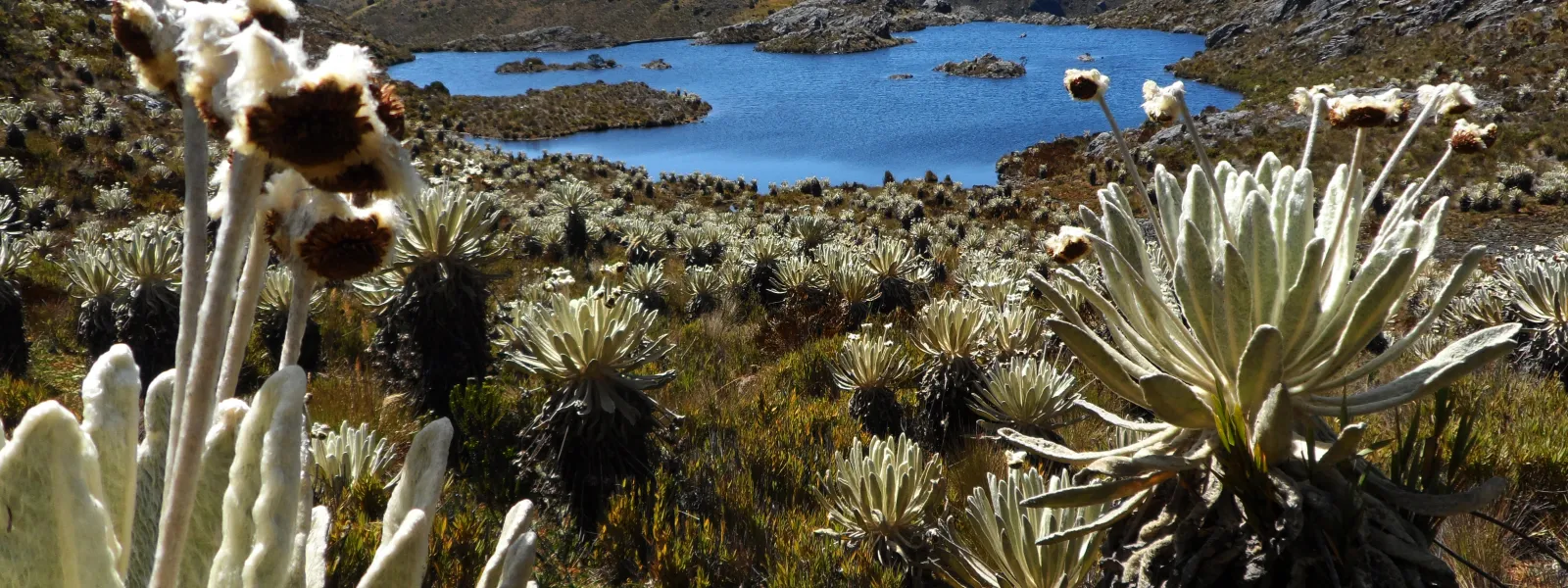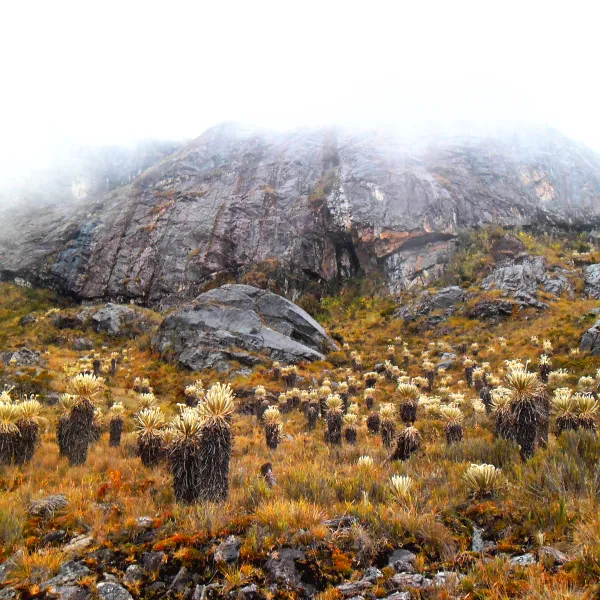
Project
Photo: Alberto Peña KayProtecting the Santurban Páramo from mining's damages
In the Andean region, high-altitude forests and wetlands called páramos capture water from fog and supply it to lowlands. In Colombia, nearly two million people rely on the Santurbán páramo for their freshwater supply.
Healthy páramos also capture large amounts of carbon, mitigating climate change, and provide refuge for hundreds of threatened species, including the iconic spectacled bear.
The land in and around the Santurbán páramo contains gold and other minerals. A Canadian corporation, Eco Oro minerals, wants to build a gold mine that would leak large amounts of cyanide and arsenic into the water coming from the páramo.
AIDA’s advocacy helped to convince the Colombian government to:
- Deny an environmental license for the Angostura mine in May 2011.
- Protect, in 2013, 76 percent of the Santurbán páramo from industrial activities—a much larger percentage than originally proposed
Together with our partners, AIDA advocated for the World Bank's divestment from the Angostura mining project, which we achieved in December 2016.
We also supported litigation that led Colombia’s highest court to reaffirm in February 2016 that mining in páramos is prohibited.
However, 24 percent of the Santurbán remains unprotected because it was not officially designated a páramo during the government's delimitation process, which was invalidated by a court system in November 2017 due to failure to consult with affected communities.
The government must now realize a new delimitation process in consultation with residents of the area. Meanwhile, the threats to Santurbán continue, with Eco Oro still angling to build its mine and another mining project seeking establishment nearby.
Partners:

Related projects
Organizations asked that the IACHR urge the Colombian State to comply with international obligations, to declare a moratorium on mining and energy projects, and establish a Working Group between authorities and the affected communities
They also asked that the Inter-American Commission on Human Rights (IACHR) urge the State to adequately attend to the victims of the forced displacement caused by the “development” projects, and to begin a dialogue between the victims and the authorities seeking effective solutions to the problem. Washington, D.C., USA – In a hearing last Monday before the Inter-American Commission on Human Rights (IACHR), in its 153rd Period of Sessions, organizations and social movements requested that the international body urge the Colombian State to recognize that forced displacement caused by the implementation of "development" projects is a human rights violation that must be prevented. They also asked that the Commission verify this grave situation with a visit to the affected areas. The organizations expressed their deep concern for the dangerous situation in which people and communities are placed as they defend their land and their environment. The resistance to megaprojects has resulted in the murder of 13 people, the disappearance of one, and threats against 25 people who defend the country’s rivers. The violence has included the recent assassination of a Nasa indigenous community leader, opposed to the Colosa mine, and a serious threat against the indigenous governor of Córdoba. The participants presented concrete cases in which the megaprojects have destroyed territories, ecosystems and ancient cultures, causing irreparable damage and leading to the forced displacement of populations. The participants presented before the IACHR three main factors that have been driving the forced displacement: 1.The close relationship between the armed conflict and the implementation of megaprojects; 2. The deregulation and violation of laws in the authorization and implementation of projects; and 3. The direct impacts from the implementation of the megaprojects. They pointed out that sociopolitical violence has enabled the implementation of mining and hydroelectric projects, causing the exodus of people from their lands and the appropriation of those lands by corporations. "The paramilitary leader Salvatore Mancuso recognized that three-thousand people from the region of Córdoba were displaced to make way for the megaprojects, because the companies needed the land for the construction of dams," the participants stated. They also indicated that the implementation of megaprojects in Colombia precludes the processes of truth, justice, and reparation, let alone any guarantees to the victims of armed conflict and development that these wrongs will not be repeated. Additionally, the participants pointed out that the State is making arbitrary use of legal instruments, such as the declaration of public utility, to clear the way for these projects, without considering their impact on human rights and the environment. The State is championing the principle of public interest, which, in practice, has been converted into a mechanism for expropriation or legal dispossession, and, as a consequence, has been the cause of the displacement. The megaprojects are having a grave impact on the ancient territories and cultures, causing irreparable damage, such as environmental contamination, that is resulting in the forced displacement of entire populations. These causes, which have created at least 200,000 victims of forced displacement, are the basis of the organizations’ request that a moratorium on mining and hydroelectric projects be instituted in Colombia as the only guarantee for the protection of further human rights violations until the policy is structurally evaluated and fundamental rights are guaranteed to those affected populations. Finally, the organizations asked for the intervention of the IACHR so that the Colombian State immediately establishes an Integrated Working Group, where the victims may participate in a discussion about mining and energy policy and have a voice in the development of a responsive business model that meets the needs of the affected communities. In this discussion, the State would also be urged to take note of the warnings issued by the Constitutional Court and the Comptroller General of the Republic regarding the need to identify alternative sources of energy, as stipulated by the World Commission on Dams.
Read more
The Protection of Coral Reefs in Mexico (in Spanish)
This report outlines the importance of coral reefs in the world—in Mexico in particular—and explores case studies, outlines relevant international treaties and obligations, and looks to best practices from nations around the region for inspiration. Download the report (in Spanish)
Read moreOrganizations alert World Bank to risks of Colombian mining investment
Delegation explains to the International Finance Corporation (IFC), a branch of the World Bank Group, illegalities and possible harms to people and the environment from Eco Oro Mineral’s Angostura mine in Santurbán, Colombia. Washington/Ottawa/Bogota/Bucaramanga. From September 11-13th, representatives from the Committee for the Defense of the Water and Páramo of Santurbán, a local coalition in the area affected by the mine, met with officials of the World Bank and the International Finance Corporation (IFC), to alert them to illegalities and socio-environmental risks associated with the Angostura mine project in Colombia, in which the IFC invested four years ago. The Committee was accompanied by representatives from the Interamerican Association for Environmental Defense (AIDA), the Center for International Environmental Law (CIEL), the Centre for Research on Multinational Corporations (SOMO), and MiningWatch Canada. IFC bought shares in Eco Oro Minerals, which hopes to open a large scale gold mine in the Santurbán páramo, a source of fresh water for millions of Colombians, habitat for endemic and threatened species, and important for climate change mitigation through the capture of atmospheric carbon. The delegation emphasized that mining puts all of this at risk and as such, according to Colombian legislation and international norms, is prohibited in páramo ecosystems. They added that cumulative effects should have been considered because the Angostura project has stimulated interest in a possible mining district in the area, in which extensive areas have been concessioned to various mining companies and that has also been affected by the armed conflict. In 2012, the Committee, with support from its allies, presented a complaint to IFC’s accountability mechanism, the Compliance Advisor Ombudsman (CAO). As a result, the CAO opened an investigation to determine whether the IFC adequately evaluated the social and environmental risks associated with this project before making its investment. The results of the investigation will likely be published before the end of the year. "We hope that, as a result of the CAO report, IFC will withdraw its investment from this mining project, since there is no way that Angostura can live up to the World Bank policies," remarked Erwing Rodríguez, a member of the Committee. "This is a very important case in Santander and the whole country. Through thousands-strong marches and many other actions in defense of water, páramos and territory, we have made it clear that we do not support large-scale mining in the Santurbán páramo," stated Miguel Ramos, another Committee member. A lawyer for AIDA, Carlos Lozano Acosta, continued: "This is a key case because it will set a precedent in the region with regard to the protection of páramos, which are vital for the provision of water and in the fight against climate change." "The World Bank is taking on an unnecessary and unprofitable risk. The value of the shares in Eco Oro that the IFC purchased has considerably dropped. This project is not good for the páramo, for Colombians, or for the IFC. We don’t understand why the IFC insists on maintaining this investment," concluded Kris Genovese of SOMO.
Read more